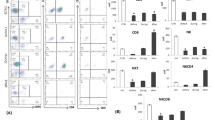Abstract
This investigation was intended to determine whether the natural killer (NK) activity of peripheral blood lymphocytes (PBL) correlated with the histopathological factor, which is thought to be a result of a balance between tumor aggression and host resistance. The NK activity of PBL from 60 patients with lung cancer was measured by the lysis of51Cr-labelled K562 target cells. The activity was significantly decreased with advancing stages of the disease, and inversely correlated with increased immunosuppressive substance levels of the serum. Histopathological factors, such as low grade pleural invasion of the tumor and abundant lymphoid cell infiltration around the tumor, were significantly associated with the high NK activity of PBL. These results show that a decrease in NK activity may play a role in identifying those individuals with a greater risk of cancer development.
Similar content being viewed by others
References
Roder JC, Haliotis T, Klein M, Korec S, JeH JR Ortaldo J, Herberman RB, Katz P, Fuci AS. A new immunodeficiency disorder in humans involving NK cells. Nature (Lond) 1980; 284: 553–555.
Green MH, Hoover RN, Fraumeni JF. Subsequent cancer in patients with chronic lymphocytic leukemia—a possible immunological mechanism. J Natl Cancer Inst 1978; 61: 337–340.
Strayer DR, Carter WA, Mayberry SD, Pequignot E, Brodsky I. Low natural cytotoxicity of peripheral blood mononuclear cells in individuals with high familial incidence of cancer. Cancer Res 1984; 44: 370–374.
Hersey P, Edwards A, McCarthy WH. Tumor-related changes in natural killer activity in melanoma patients. Influence of stage of disease, tumor thickness, and age of patients. Int J Cancer 1980; 25: 187–194.
Pross HF, Baines MG. Spontaneous human lymphocytemediated cytotoxicity against tumor target cells. 1. The effect of malignant disease. Int J Cancer 1976; 18: 593–604.
Sibbit WL, Bankhurst AD, Jumonville AJ, Saiki JH, Saier JH, Doberneck RC. Defects in natural killer cell activity and interferon response in human lung carcinoma and malignant melanoma. Cancer Res 1984; 44: 852–856.
Bloom HJG, Richardson WW, Field JK. Host resistance and survival in carcinoma of breast: A study of 104 cases of medullary carcinoma in a series of 1411 cases of breast cancer followed for 20 years. Br Med J 1970; 3: 181–188.
Loachim HL, Dorsett BH, Paluch E. The immune response at the tumor site in lung carcinoma. Cancer 1976; 38: 2296–2309.
Bluck MM, Leis HP. Cellular responses to autologous breast cancer tissue. Cancer 1971; 28: 263–273.
Japanese Research Society for Lung Cancer. The General Rules for Lung Cancer Study in Surgery and Pathology 2nd Edition, Tokyo: Kanehara Shuppan Co. Ltd. 1982. (in Japanese)
Japanese Research Society for Gastric Cancer Igan Toriatsukai Kiyaku. 11th Edition, Tokyo: Kanehara Shuppan Co. Ltd. 1985. (in Japanese)
Fujii M, Takahashi N, Hayashi H, Yagihashi Y, Oguchi Y, Matsunaga K, Yoshikumi C. Purification and characterization of immunosuppressive (IS) substance obtained from ascites fluids of colon cancer patients. Clinical Biochemistry 1987; 20: (in press).
Tamara K, Shibata Y, Matsuda Y, Ishida N. Isolation and characterization of an immunosuppressive acidic protein (IAP) from ascites fluids of cancer patients. Cancer Res 1981; 41: 3244–3252.
Krant MJ, Manskoff G, Brandrup CS, Madoff JMA. Immunologic alterations in bronchogenic cancer. Cancer 1968; 21: 623–631.
Wells SA, Burdick JF, Joseph WL, Christanson C, Wolfe WG, Adkins PC. Delayed cutaneous hypersensitivity reactions to tumor cell antigens and to nonspecific antigens. J Thorac Cardiovasc Surg 1973; 66: 557–562.
Han T, Takita H. Immunologic impairment in bronchogenic carcinoma: A study of lymphocyte response to phytohemagglutinin. Cancer 1972; 30: 616–620.
Wanebo HJ, Rao B, Miyazawa N, Martini N, Middleman MP, Oetlgen HF, Beatties EJ. Immune reactivity in primary carcinoma of the lung and its relation to prognosis. J Thorac Cardiovasc Surg 1976; 72: 339–347.
Klein E, Svedmyr E, Mikael J, Vanky F. Functional studies on tumor infiltrating lymphocytes in man. Isreal J Med Sci 1977; 13: 747–752.
Vose BM, Vanky F, Klein E. Human tumor lymphocyte interreactionin vitro V. Comparison of the reactivity of tumor infiltrating blood, and lymph node lymphocytes with autologous tumor cells. Int J Cancer 1977; 20: 895–902.
Yoshida T, Shirakusa T, Shigematsu N, Ushijima Y, Inokuchi K. Histopathological factors predictive for prognosis of lung cancer. Jpn J Surg 1979; 9: 210–217.
Shimokawara I, Imamura M, Yamanaka N, Ishii Y, Kikuchi K. Identification of lymphocyte subpopulations in human breast cancer tissue and its significance. Cancer 1982; 49: 1456–1464.
Suzuki R, Suzuki S, Ebina, Kumagai K. Suppression of alloimmune cytotoxic T lymphocyte (CTL) generation by depletion of NK cells and restoration by interferon and/or interleakin 2. J Immunol 1985; 134: 2139–2148.
Uchida A, Michsche M. Natural killer cells in carcinomatous pleural effusion. Cancer Immunol Immunother 1981; 11: 131–138.
Spjut HJ, Roper CL, Butcher HR. Pulmonary cancer and its prognosis. A study of the relationship of certain factors to survival of patients treated by pulmonary resection. Cancer 1961; 14: 1251–1258.
Collier FC, Blakemore WS, Kyle KH, Enterline HT, Kirby CK, Johnson J. Carcinoma of the lung: Factors which influence five year survival with special reference to blood vessel invasion. Ann Surg 1957; 146: 417–423.
Yamashita K, Hayashi H, Mure K, Ishihara M, Shimizu T. Serum immunosuppressive substance in patients with gynecologic malignancies, and in pregnant women. Cancer 1986; 57: 69–74.
Ohnishi K, Fuchimoto S, Hamada F, Tanaka N, Orita K. Immunosuppressive mechanisms of IS substance detected in the serum of gastrointestinal cancer patients. Shoukaki to meneki 1985; 14: 267–171. (in Japanese)
Author information
Authors and Affiliations
Rights and permissions
About this article
Cite this article
Terazawa, A., Tanaka, N., Senou, N. et al. Natural killer activity of peripheral blood lymphocytes and its relation to histopathological factors of lung cancer. The Japanese Journal of Surgery 17, 236–242 (1987). https://doi.org/10.1007/BF02470694
Received:
Issue Date:
DOI: https://doi.org/10.1007/BF02470694




